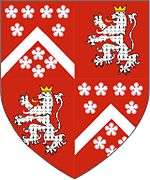Thomas Berkeley (Leics MP 1472)
| Sir Thomas Berkeley | |
|---|---|
|
Berkeley of Wymondham arms:- Quarterly. 1&4: gules, a chevron between ten cinquefoils argent. BERKELEY: 2&3: gules, a lion rampant ermine, crowned or. HAMELYN.[1] | |
| Sheriff of Rutland | |
|
In office 1443[2] – 1444[2] | |
| Monarch | Henry VI |
| Sheriff of Warwickshire and Leicestershire | |
|
In office 1454[2] – 1455[2] | |
| Monarch | Henry VI |
| M.P. for Leicestershire | |
|
In office 1472[2] – 1475[2] | |
| Monarch | Edward IV |
| Personal details | |
| Born | Wymondham, Leicestershire |
| Died | 1488[3] |
| Spouse(s) | Emma/Petronella Brokesby |
| Children |
Sir Maurice Berkeley Lawrence Berkeley Elizabeth Berkeley Edith Berkeley Joyce Berkeley ? Berkeley |
| Parents |
Sir Laurence Berkeley[3] & Joan Woodford[3] |
Sir Thomas Berkeley (died 1488), of Wymondham, Leicestershire was an English lawyer and politician who represented Leicestershire in Parliament and served as Sheriff for Rutland, Warwickshire and Leicestershire.
Ancestry
He was the eldest son of Sir Laurence Berkeley of Wymondham (died in France in 1458[3]) and Joan sister of the Agincourt veteran[4]:762 Sir Robert Woodford, Knight Banneret[4]:227 of Sproxton.[3]
Sir Lawrence Berkeley was the 2*great grandson of Sir Thomas Berkeley, Lord of Coston, 2nd son of Thomas de Berkeley, 1st Baron Berkeley and Jane daughter of William de Ferrers, 5th Earl of Derby.[3]
Sir Thomas Berkeley, Lord of Coston had moved to Wymondham upon his marriage to Isabel, daughter of Sir John Hamelin of Wymondham.[3][nb 1]
Career and Life
Thomas was a Justice of the Peace for Leicestershire from 1442–58 and Sheriff of Rutland between 1443 and 1444.[2] He was admitted as a Fellow of Lincoln's Inn in 1449 by special admission.[6]
In December 1457 he was appointed as one of Leicestershire's Commissioners of Array who were responsible for raising 226 archers to help repel Richard, Duke of York's Yorkist rebellion and again in 1459.[5] He had been knighted by Nov 1460 perhaps having taken part in the Battle of Northampton but changed allegiance after the bloody Battle of Towton brought about the end of Henry VI's reign and the start of Edward of York's.[5]
Towards the end of 1465 Thomas became involved in a fight with Sir John Bourchier over the wardship and marriage of the underage grandson of former M.P. Sir Manser Marmion and who Thomas was accused of abducting.[7] The Marmion's estate was composed of over 2,500 acres spread over several counties so, as well as being an attractive prize, was owned by way of a complex set of homages and services to multiple overlords.[7] It would seem Thomas won and later wed his daughter Edith to the Marmion heir.[8][9][10]
In 1468 Thomas accused William Purley (whose family had lived in Wymondham since the early 13th century) of entering his land two years earlier and stealing 20 hares, 200 rabbits, 12 pheasants and 20 partridges using swords, bows and arrows.[11] William was either found not guilty or let off for some reason as he appears to have later married Thomas Berkeley's daughter Joyce.[8][12]
Sir Thomas was appointed as Sheriff of Rutland in 1471 and as a Justice of the Peace for Rutland from 1470-75.[2]
He served in Parliament for Leicestershire between 1472 and 1475.[2]
Thomas died in 1488 and is buried in an alabaster topped altar tomb with his wife Petronella in Wymondham St Peters.
Family
Sir Thomas married Emma[1]/Petronella[3] daughter of Sir William Brokesby,[3] Marshall of the Kings Hall, and had the following issue:-
- Sir Maurice Berkeley[1] (d.30 Nov 1522)[1] son and heir.
- Lawrence Berkeley[1]
- Elizabeth Berkeley[1] (d.1504[8]) m. Sir William Hussey,[1] Chief Justice of the King’s Bench.
- Edith Berkeley[9] (d.23 Oct 1538[9]) m. Mauncer Marmion,[8][9][10] (Sheriff of Lincolnshire in 1497) and buried in a tomb together in Rippingale Church.[9][10]
- Joyce Berkeley (d.1530) m. William Purley[8][12]
- ? Berkeley m. ? Gaton[8]
Thomas was the 3*great-grandfather of Sir Henry Berkeley 1st Baronet of Wymondham.[3]
Notes
- ↑ Sir John's Great Grand-father Sir William Hamelyn is thought to have gone on the 3rd Crusade with Richard the Lionheart. He is now thought to be the knight represented in a stone effigy in Wymondham church and not, as Nicholls suggested, Sir John Hamelyn who only appears to have taken part in the Scottish wars.[5]
References
- 1 2 3 4 5 6 7 Visitation of Leicestershire 1619, London: Harleian Society, 1870
- 1 2 3 4 5 6 7 8 9 Josiah Wedgwood (1936), History of Parliament 1439-1509 Biographies (hardback), London: HMSO
- 1 2 3 4 5 6 7 8 9 10 John Burke & John Bernard Burke (1844), Extinct and Dormant Baronetcies of England, Ireland and Scotland (hardback), London: John Russell Smith
- 1 2 John Burke (1838), A Genealogical and Heraldic History of the Commoners of Great Britain and Ireland (hardback), 4, London: Henry Colburn
- 1 2 3 Ralph Penniston Taylor (1996), A History of Wymondham, Wymondham: Witmeha Press
- ↑ Lincolns Inn Admission Register (hardback), London: Lincolns Inn, 1897
- 1 2 George F. Farnham (1929–33), Leicestershire Medieval Village Notes, II, Leicester: W.Thornley & son, p. 275
- 1 2 3 4 5 6 Will of Elizabeth Huse 1504, National Archives Kew: Prerogative Court of Canterbury, 1504
- 1 2 3 4 5 Holles Lincolnshire Church Notes, I, Lincolnshire Records Society, 1910
- 1 2 3 E.R.Kelly, ed. (1885), Kellys Directory of Lincolnshire, London: Kelly & Co, p. 605
- ↑ George F. Farnham (1929–33), Leicestershire Medieval Village Notes, IV, Leicester: W.Thornley & son, p. 316
- 1 2 Descents and Pedigrees of Families in Lincolnshire, London: British Library, Harl MS 5874
External links
- Hamelin Knight in Wymmondham St Peters thought to be Sir John's Great Grand-father Sir William Hamelyn
- Wymondham St Peters
